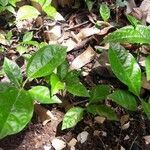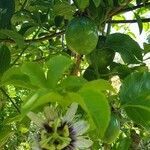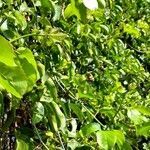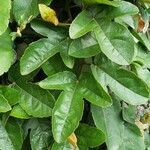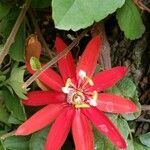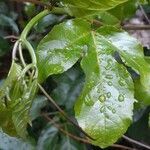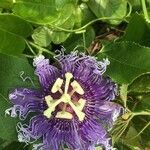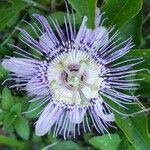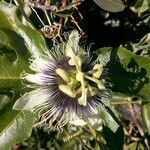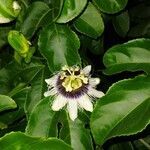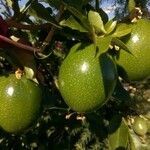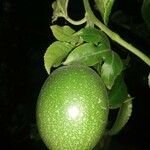Climber to c. 15 m, perennial, glabrous throughout (except ovary); stem sometimes ± angular. Leaves 3-lobed up to 3/4 the blade, rarely without lobes, suborbicular to broadly ovate in outline, 5-11 x 6-12 cm, 3-plinerved, subcoriaceous, base acute to cordate, lobes elliptic to oblong, up to 8 cm, apex acute, shortly acuminate; margin serrate; petiole 1-4 cm; glands on petiole 2, wart-like, situated at transition of or up to 0.5 cm below the blade; blade-glands absent. Stipules lanceolate-linear, c. 1 cm. Inflorescences 1-flowered, the straight peduncle (pedicel) 3-6 cm, inserted beside a simple tendril 5-20 cm; bracts and bracteoles ovate, acute, 1.5-2 cm, glandular-serrate, forming an involucre. Flowers 4-7 cm diam., white, corona threads purplish towards base; hypanthium cup-shaped, c. 1 x 1-1.5 cm; sepals oblong, 2-3 cm, corniculate; petals oblong, 1-2.5 cm, obtuse; corona composed of several series of threads, the outer 2 series 0.5-2.5 cm, the inner ones much shorter; operculum membranous, incurved, crenulate-fimbriate; disc (limen) cupuliform, entire or crenulate. Androgynophore 6-8 mm, thickened towards base; filaments sub-subulate, 6-8 mm; anthers 8-10 mm; ovary subglobose to ellipsoid, 3-5 mm, glabrous or shortly pubescent; styles 10-12 mm. Fruit berry-like, with coriaceous-leathery pericarp, globose to ellipsoid, excluding the 0.5-1.5 cm long gynophore, 4-5 cm diam., glabrous, purplish or yellow; seeds many, ellipsoid, 5-6 mm.
Perennial vine to c. 15 m long, with simple axillary tendrils, glabrous except ovary. Stem terete or subangular, striate. Stipules linear-subulate, 1–1.3 cm long, 1–2 mm wide, with entire or glandular-serrulate margin. Leaves alternate, 3-lobed for more than ½ length, young leaves rarely simple and ovate; lobes widest near middle, ovate or ovate-oblong, acute or acuminate, rarely obtuse, each with a single main vein; lamina subcoriaceous, lustrous adaxially, 5–13.5 cm long, 7–12 cm wide, with 1 or 2 small cup-shaped glands near base of sinuses, base rounded or cordate, margin serrate; petiole 3–4 cm long, with two sessile or short-stipitate glands (to c. 5 mm long) near lamina. Flowers bisexual, borne singly in leaf axils, (4–) 6–8 cm diam.; pedicels 2–6 cm long; bracts 3, ovate to broadly ovate, 1–2.5 cm long, 1–1.5 cm wide, with serrate to lacerate margin, free. Sepals light green or white adaxially, green abaxially, 2–4 cm long, keeled, terminating in an awn 2–6 mm long. Petals white, 1.8–3 cm long. Corona of 4 or 5 series of filaments; outer 2 series purple in basal half, white and crisped in apex half, 1–2.5 cm long; inner series green and purple, 1–3 mm long. Operculum membranous, entire or irregularly lacerate at apex, 1–2 mm long. Androgynophore straight, 10–13 mm long. Stamens 5. Styles 3. Fruit an ovoid or globose berry, 5–7 cm long, 4–6 cm wide, yellow, greenish yellow or purple at matutrity. Seeds minutely reticulate.
Herbaceous vines, woody at base, ca. 6 m long. Stem slender-striate, glabrous. Leaves 6-13 × 8-13 cm, membranous, base cuneate or cordate, deeply 3-lobed, middle lobe ovate, lateral lobes ovate-oblong, margin glandular-serrate, with 1 or 2 small cup-shaped glands near base of sinuses, glabrous. Inflorescence a reduced cyme, central flower not developed, one lateral branch converted to a tendril, flower opposite tendril; bracts green, broadly ovate or rhombic, 1-1.2 cm, margin irregularly serrulate. Pedicel 4-4.5 cm, biglandular at apex. Flowers 4-7 cm in diam.; hypanthium 0.8-1 × 1-1.2 cm. Sepals green outside, light green or white inside, 2.5-4 × ca. 1.5 cm, awn 2-4 mm. Petals 2.5-3 cm × ca. 8 mm. Corona in 4 or 5 series; outer 2 series ligulate with filiform distal half, 2-2.5 cm, base light green, middle purple, apex white; inner 2 or 3 series filiform, 1-3 mm, green and purple; operculum recurved, 1-1.2 mm, margin entire or irregularly lacerate apically; disk ca. 4 mm high, membranous; androgynophore 1-1.2 cm tall; trochlea (ring-shaped enlargement on androgynophore) just above disk. Filaments 5-6 mm, flat, coherent at base; anthers light yellow-green, oblong, 5-6 mm. Ovary obovoid, ca. 8 mm, glabrous to pubescent; styles flat; stigma reniform. Fruit purple at maturity, ovoid, 3-4 cm in diam., glabrous. Seeds many, ovoid, 5-6 mm. Fl. Jun, fr. Nov.
Vigorous vine, glabrous except for pistil and stamens. Shoots slightly angular. Lvs deeply 3-lobed, but entire on young plants; petiole 1-3 cm long, with 2 sessile glands near apex; stipules 10-15 mm long, linear-subulate, entire; lamina lobes ± elliptic, submembranous, deep shining green above, rounded at base; middle lobe largest, 6-10 × 3-5.5 cm, serrate or serrulate, obtuse to acute. Fls ☿, solitary. Pedicels 4-6 cm long at flowering. Bracts 1.5-2 cm long, ovate, free, coarsely serrate. Hypanthium inconspicuous. Sepals 2.5-3 cm long, oblong, green on reverse, white inside; petals white, similar to sepals; corona threads 2-2.5 cm long, white with purple base. Filaments puckered, purple towards base, otherwise white; anthers 8-10 mm long, > filaments. Ovary puberulent. Fr. 5-6.25 × 4.75-5.75 cm, broad-ellipsoid or subglobose, dull purple; pulp orange, sweet. Seed c. 5 mm long, ovate, black, pitted.
A vine which continues to grow for several years. The main vine becomes woody. Vines can be 6-7 m long. It climbs by tendrils. The leaves are shaped like the fingers on a hand with three lobes. They are 5-10 cm long. The vine can set flowers at each leaf. The flowers are white and often tinted purple. They are 5 cm across. The fruit are oblong and thickly dotted with purple when ripe. The skin is hard and they have a sweet smell. The flesh is orange. The seed occupy most of the inside with a small amount of flesh. The flesh is edible. The seeds are black. The flowers open in the morning. There are many named cultivated varieties.
Leaf-lamina up to 13 × 15 cm., 3-lobed to below the middle of the lamina, the lobes 2–4 cm. wide, acute or acuminate, rarely subobtuse, serrate, rounded or shallowly cordate at base, subcoriaceous, pale green or yellow-green, glossy above, paler and not glossy beneath; petiole up to 4 cm. long, with 2 glands at the apex, the glands sessile or shortly stipitate; stipules c. 10 × 1 mm., linear-subulate, entire or minutely glandular-serrulate.
Corona with the filaments in 4 or 5 rows, those of the 2 outer ones 1·5–2·5 cm. long, filiform or narrowly liguliform, crispate towards the apex, white, purple at base, those of the other rows 2–2·5 mm. long, linear or dentiform.
Climber, up to 15 m high. Bracts and bracteoles conspicuous, foliaceous, forming an involucre, serrate-denticulate. Stipules lanceolate or filiform. Leaves 3-lobed. Flowers white; corona threads purplish towards base.
Plant glabrous; involucral bracts 1½-2 cm; petals white, corona filaments white with purple base; fruit ellipsoid, 4-6 cm long, purplish, sometimes yellow.
Bracts 2–2·5 × 1–1·5 cm., ovate, obtuse or acute at the apex, serrate, pectinate or almost lacerate, often glandular at margin.
Fruit 4–5 cm. in diameter, ovoid or globose, yellow, greenish-yellow or purplish.
Large herbaceous, glabrous (except ovary) perennial climber, up to 15 m.
Sepals 3–3·5 × 1 cm., oblong, horned, green outside, white inside.
Operculum membranous, incurved, entire or shortly fimbriate.
Ovary ovoid or globose, sericeo-tomentose or glabrous.
Stems ± terete, striate; internodes up to 9 cm. long.
Seeds 5–6 times; 3–4 mm., ovoid, minutely reticulate.
Petals 2·5–3 × 0·5–0·7 cm., oblong, obtuse, white.
Tendrils c. 10 cm. long, stout, simple.
Limen cupuliform, entire or crenulate.
Flowers solitary, up to 7 cm. in diam.
Peduncles up to 6 cm. long, stout.
